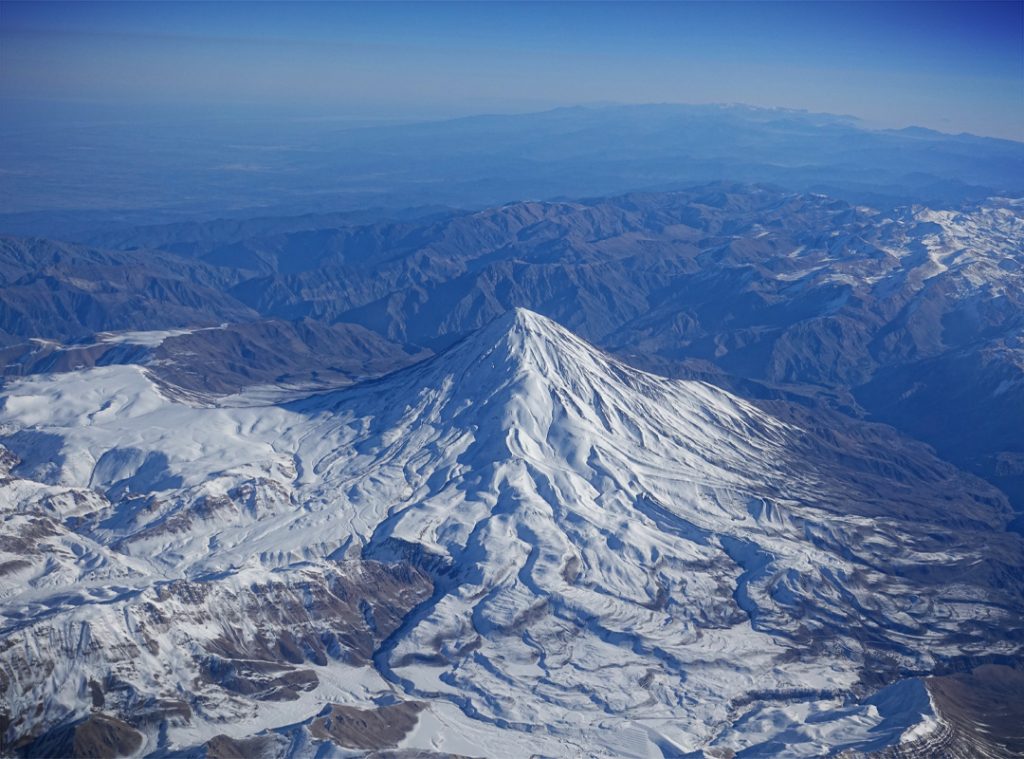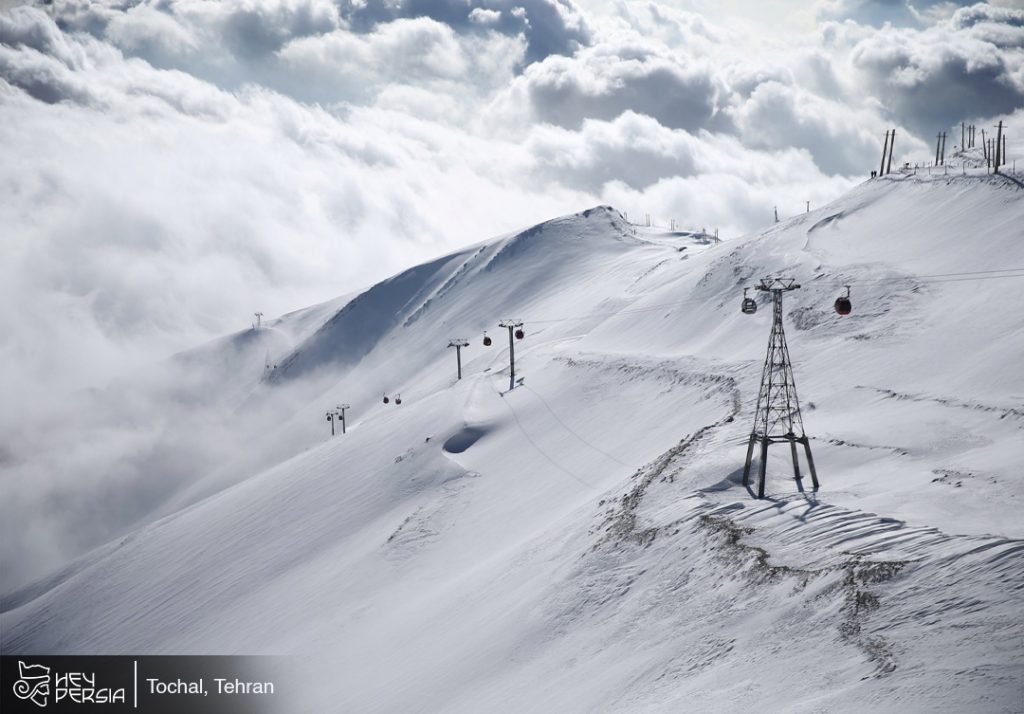The magnificent and solid Damavand peak is one of the most important tourist attractions in Iran, which has had a special place in the culture and legends of this ancient land for a long time. This 5671 km peak is located in Larijan city of Mazandaran province near Amol city. If you like learning more about the highest mountain in Iran and West Asia, stay with us on the Hey Persia blog.
Where is Damavand peak?
Generally, Damavand peak, the highest volcanic mountain in Asia and the Middle East, is located in Mazandaran province in the north of the country. In terms of country divisions, this beautiful peak is in a part of Amel city Larijan in the central Alborz mountain range. Additionally, If the weather is clear and sunny, you can see this beautiful mountain from the cities of Tehran, Varamin and Qom. To climb Damavand peak, you need to travel to Damavand city. The distance of this high peak from Damavand city is 26 km, from Amol 62 km and from Tehran about 69 km.
Damavand peak weather
Due to the height of this area, the precipitation in Damavand Mountain is in the form of snow, and its annual precipitation is to be around 1400 mm. The minimum temperature of Damavand peak in winter reaches minus 60 and the highest temperature reaches minus 2 in summer. The wind speed at Damavand peak is about 150 km/h and in the foothills it reaches 70 km/h. Most of the winds in this region blow from the west and northwest. The air pressure in this area is half of the air pressure at sea level.
The age of Damavand peak
Damavand peak is to be 38500 years old. This mountain was in the fourth geological period, the Holocene era, and its first eruption occurred 1.78 million years ago. It is that the highest mountain in Iran is a semi-active volcanic mountain. The existence of sulfur springs and hot water in the region is the proof of half of its activity. The most and major activity of this volcanic mountain happened nearly 10 thousand years ago.

Information about the characteristics of Damavand peak
Generally, Damavand peak, as mentioned, has a height of about 5671 km. This towering mountain has a 400-meter volcanic crater covered by a lake of ice. Although, Around the crater of the mountain, there are holes of chimneys. In addition, there are volcanic bowls in its southern and northern parts. In such a way that the diameter of its northern bowl reaches 9 km. It is the Assyrians Mount Damavand a mine of lapis lazuli, and at the time of their attack on the Iranian plateau, this mountain was part of the territory of the Medes. Mount Damavand was a national natural monument in 1381 and in 1387 as the first natural monument in Iran. It was in the list of national works of the country.
Damavand peak in the culture and legends of Iranian literature
The story of Fereydon and Zahak is the most famous legend about Damavand peak. According to legends, Fereydoun, the most famous mythological figure of Iran, imprisoned Zahak in one of the caves of Mount Damavand and will remain there until the end of time and the appearance of the savior of the world. Some residents of this area still believe that Dahhak is imprisoned in Damavand, and they consider the voices that are sometimes heard from the mountain to be a witness to this story.
It is mentioned in Balami’s history that Kiyomarth lived in Mount Damavand and even his grave is located in that area. It is even said that the archer Arash in Manouchehr kingdom shot an arrow from the top of Damavand peak to determine the border between Iran and Turan. Famous Iranian poets such as Ferdowsi in Shahnameh, Asadi Toosi in Garshasp Nameh, an ode by Nasser Khosrow, etc. have also written poems about Mount Damavand.
What is the meaning of the name Damavand?
Damavand’s name is as Damavand and Danbavand or even Debavand. Of course, it is called “bacon” in the Torah book. This mountain is also known by different names, such as Bikini, which means Azure Mountain, and Jebel Al-Jud. “Farhang Moin” says about the reason for choosing the name Damavand for this 5,671 km mountain: Damavand means a place with heat, smoke and steam.
Of course, Ahmad Kasravi has a different opinion about this and believes that the name Damavand is related to “Nahavand”, Nahavand means a city or settlement or a fortress standing in front and Damavand means a city, settlement or a fortress standing behind. Moreover, In the beginning of his travelogue, Nasser Khosrow Qabadiani writes about Mount Damavand: “Between Ri and Amel, Mount Damavand is like a dome called Lavasan.” In Middle Persian, Lavasan means “Pahlavi”, the blade of the mountain from where the sun rises.
Vegetation of Mount Damavand
The vegetation of this area is very rich in such a way that there are medicinal plants that are mentioned in the authoritative books of botany. In addition, there are special plants in this area that only grow at this height. Some of the special plants named after Damavand are: Mirhasan Damavandi’s hat, Damavandi kezel, Damavandi yarrow, Damavandi pyrgiah, Damavandi’s beard, Damavandi’s don’t forget me, Damavandi’s bell, Damavandi’s linen and Damavandi’s vetch.
In this area, you can see all kinds of thorn bushes, such as Mir Hasan Damavandi’s cap, Kharpashti, thousand thorn species (such as Goon), etc. Among the other types of Damavand plants are alpine pine, semi-spherical mountain spruce, gorse, rock jasmine, uzmaki kohsari, pirbahar denai, chestnut clover, mountain sorrel, alborazi dogwood, bushy plakhor, grape galash, tyre gol, Caucasian wild nester, etc. Cited. Fortunately, the heights of Mount Damavand, about 4000 meters down, are very rich in terms of pastures and pastures.

Damavand mountain wildlife
This area is host to various animals, which we will mention below. Hunting animals such as wolves, foxes, jackals, and dogs can be seen around Mount Damavand at an altitude of 4,000 meters. Additionally, A bear also lives in the west and north of Mount Damavand. The most important herbivores of Mount Damavand include: goats, sheep, pigs, rabbits, and goats. Birds of prey such as golden eagles, owls and birds such as tiho, partridge, quail, black-breasted parrot and woodpecker live in this area.
Climb to Damavand Peak
Climbing Damavand Peak is not an easy task and people who are not professional climbers cannot do it. Also, According to the Iranian Mountaineering Federation, climbing Damavand peak is equivalent to winning a bronze medal in national mountaineering competitions. Moreover, There are 4 routes to do this climb, which are:
Northern front
Northeast front
Western Front
South front
The easiest way to climb is the south face and the most difficult is the north face. All the mentioned routes have parapets in the middle of the road and 3 routes on the north, south and northeast front are located near the village.
7 glaciers on the way to Damavand peak
Seyole Glacier (Northern Front)
Dubey Sel Glacier (northern front)
Refrigerator of dolls (north face)
Yakhar Valley Glacier (northeast)
Refrigerator head
Northwest Glacier
western glacier
Ice waterfall
The ice waterfall with a height of 7 meters and a diameter of 3 meters is one of the most unique waterfalls in the world, which is located on the southern face of Mount Damavand. The ice of this waterfall never melts. As a result, In the summer, around noon and an hour later, with the sunlight of Damavand Peak In Iran, the air temperature rises a little and reaches above zero degrees, and the waterfall opens a little and the water flows. But around 4:00 PM, the air temperature drops below zero degrees again and the melted ice freezes again. As a result, the waterfall always remains frozen.
Damavand Peak In Iran
Damavand peak in Iran is a symbol of stability, steadfastness and resistance. As we said, this natural work registered as a natural work by the Environmental Organization in 2001. Additionally, In 2007, this magnificent peak was as the first natural work in the form of natural heritage by the Cultural Heritage Organization. In this article, we tried to introduce you to all the small and large features and everything you need about Damavand mountain and peak. If you have more information about this upright symbol of our country, you can write it in the comments and suggestions section and share it with us. Thank you very much in advance for your cooperation.
Finally, Hey Persia tourism magazine has been established with the aim of familiarizing Iranians with the natural-historical tourist attractions of our beautiful country. If you also want to learn more about the sights of our vast country, register on the Hey Persia website and learn about the most important events and tourist places of our country.





